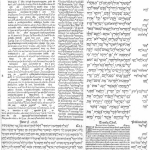 The travel narrative begins with the brief encounter where Jesus is rejected in Samaria, and rebukes his disciples after they ask if they should burn the Samaritan village. There are a few things we know. Jesus is either in or heading toward Samaria. We know Jesus is planning on staying in a village in Samaria, but he is denied. There is no record of Jesus interacting with the village directly, but his movements are known to the Samaritans. The interaction between Jesus and the Samaritans seems to be mediated through Jesus’ messengers. The reason for his rejection is because of where he is heading, which is Jerusalem, why that is important is not explicit in the text so some background on who the Samaritans were should be mentioned.
The travel narrative begins with the brief encounter where Jesus is rejected in Samaria, and rebukes his disciples after they ask if they should burn the Samaritan village. There are a few things we know. Jesus is either in or heading toward Samaria. We know Jesus is planning on staying in a village in Samaria, but he is denied. There is no record of Jesus interacting with the village directly, but his movements are known to the Samaritans. The interaction between Jesus and the Samaritans seems to be mediated through Jesus’ messengers. The reason for his rejection is because of where he is heading, which is Jerusalem, why that is important is not explicit in the text so some background on who the Samaritans were should be mentioned.
The Samaritans were a group of people who had their own version of the Law of Moses. For both Jews and Samaritans this Law or Torah was essential to how and where they worshiped. Jews worshiped in Jerusalem, but Samaritans worshiped on another mountain called Gerizim.1 Their was a great deal of animosity between these groups. We have records of pilgrims traveling through this region being harassed by Samaritans.2
Luke’s account is the only one to record Jesus traveling to Jerusalem through Samaria. Matthew and Mark seem to indicate Jesus traveled around through an area called “Perea” which was located on the east bank of the Jordan.3 This encounter with the Samaritans may have been the impetus for this movement, however this conclusion would be speculation at best.
There was a parallel development of Samaritan culture with that of the Jews. 4 One aspect of this was an expectation of a Christ like figure. Although we don’t know what the Samaritan people actually heard about Jesus, but if he was thought to be a messiah, he would not have fit the Samaritan mold. According to the Samaritans there would be a prophet/king who would come from the east called Taheb.5 Jesus as a Northerner would not have fit that expectation.
There is one more background issue that many scholars think is related that needs to be discussed before we can properly evaluate this piece of the puzzle. In the book of Malachi there seems to be a promise that Elijah will come before the day of the LORD (Malachi 4:5). This expectation is in the back of many of the minds of Jewish people during the time of Jesus. Because of this, Jesus’ identity is often cast by both the gospel writers in contrast against and in parallel with the life and deeds of Elijah. Some scholars think this passage is an example of one such parallels. Elijah’s ministry brought down fire from heaven on more then one occasion. Fitzmeyer notes that there does seem to be a particular similarity between the Disciples desire for retribution in this passage and the fire that consumed those who opposed Elijah in 2 Kings 1. Although he does note that the language of 1 Kings 1:10 in the Septuagint is different then the language used in Luke.6 Parallels to Elijah, although not explicit, are strong enough that they merit consideration both in this section and in the section immediately following where Jesus confronts three would-be disciples.
While reading this passage a number of theological questions emerge:
- Why is Jesus setting his Face toward Jerusalem? It’s obvious there is a significance, but what is it?
- Why are the Samaritans seen in a negative light here while they seem to be shown more positively in other sections of Luke? Look at 10:30-37 and 17: 11-19 for Luke’s other treatment of the Samaritans.
- What is the significance of Jesus’ Rebuke? Although Marshall believes it comes from Mark 8:33 there might be more at play here then arbitrary redaction.7
- This incident is bracketed by Jesus sending the Twelve out to villages at the beginning of Chapter 9 and Jesus sending out seventy two and the beginning of Chapter 10. Is this passage related to the sending of the disciples before and after?
- Is there a moral or a principal being taught or demonstrated in this passage? If so what is it?
In the next section of our analysis we will be looking at this story verse by verse. Re-read the questions above, and review Luke 9 and 10 as a whole before you proceed.
notes
1 Fitzmyer, J. A. The Gospel According To Luke. 2 vols. Anchor Bible. (Garden City, N.Y.:Doubleday, 1981), 827-829.
2 Fitzmyer, J. A. The Gospel According To Luke. 2 vols. Anchor Bible. (Garden City, N.Y.: Doubleday, 1981), 829.
3 Fitzmyer, J. A. The Gospel According To Luke. 2 vols. Anchor Bible. (Garden City, N.Y.: Doubleday, 1981), 824.
4 Nolland, J. Luke. 3 vols. Word Biblical Commentary. (Dallas: Word, 1989-1993), 536.
5 Evans, Craig A. Ancient texts for New Testament studies: a guide to the background literature. (Peabody MA: Hendrickson Publishers, 2005), 303.
6 Fitzmyer, J. A. The Gospel According To Luke. 2 vols. Anchor Bible. (Garden City, N.Y.:
Doubleday, 1981), 824.
7 Marshall, I. Howard. The Gospel of Luke. (Grand Rapids: Eerdmans, 1978), 407.












